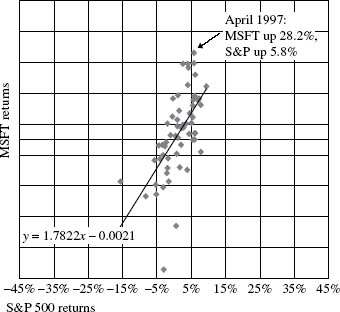27
Understanding Regressions
27.1 KEY TAKEAWAYS
- A low R-squared does not mean the model is flawed.
- Statistically significant observed relationships do not ensure causality.
- Interpreting regressions hinges on the nature of underlying observations.
There are a handful of key statistics used to describe linear regressions. Two of these define the line itself: The slope (beta) and y-intercept (alpha). Some statistics describe the “fit” or explanatory power of the model: r (correlation coefficient) and R-squared (the coefficient of determination). Other important statistics measure the precision or reliability of the model and its estimates under normal conditions, such as standard errors and t-statistics.
We use the calculation of a stock's beta, per the traditional CAPM approach, to estimating cost of equity, to frame our discussion of the key statistical measures related to linear regression analysis.

Figure 27.1 Microsoft (MSFT) vs. S&P 500 Index returns: Jan '96–Dec '00
Figure 27.1 shows monthly Microsoft returns (on the vertical y-axis) plotted against monthly total returns of the S&P 500 Index (on the horizontal x-axis). It is common practice in regression analysis to present the dependent variable on the y-axis and the independent variable on the x-axis. Keep in mind that a regression equation only captures the degree of common variation among variables; correlation does not ...
Get Equity Valuation: Models from Leading Investment Banks now with the O’Reilly learning platform.
O’Reilly members experience books, live events, courses curated by job role, and more from O’Reilly and nearly 200 top publishers.

